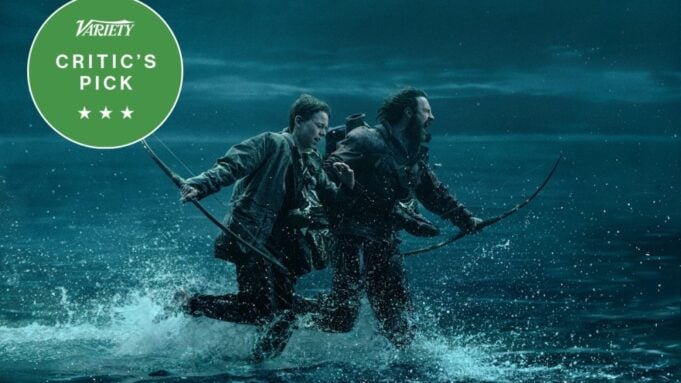In “28 Days Later,” it took less than four weeks to transform London, one of the world’s busiest and most advanced cities, into an inhospitable ghost town after an outbreak of the ultra-contagious Rage virus struck the human population. Just imagine what another 10,000 or so days might do.
That’s where boundary-pushing director Danny Boyle and speculative fiction superbrain Alex Garland pick up their 2002 dystopian horror saga with “28 Years Later,” swinging to the opposite end of the U.K. to follow an entirely new set of characters. You don’t have to be a math whiz to spot that the creative duo are five years ahead of schedule. But when Boyle and Garland landed on a compelling enough reason to check back on the now-quarantined country, it hardly seems reasonable to wait. And what better catalyst could there be than the real-world disruptions caused by self-imposed isolation (Brexit) and a once-in-a-century global pandemic (COVID-19)?
Where the original film tapped into society’s collective fear of infection, its decades-later follow-up (which undoes any developments implied by “28 Weeks Later” with an opening chyron that explains the Rage virus “was driven back from continental Europe”) zeroes in on two even most primal anxieties: fear of death and fear of the other. To which you might well ask, aren’t all horror movies about surviving an unknown threat of some kind? Yes, but few have assumed the psychic toll taken by such violence — or stared death directly in the bloodshot eyes — quite so effectively. Though conceived as the start of a new trilogy, “28 Years Later” towers on its own merits (part two, subtitled “The Bone Temple,” is already in the can and expected next January).
Apart from its first and last scenes, which introduce a charismatic lad named Jimmy (played by “Sinners” villain Jack O’Connell) who learns to defend himself after seeing his local priest and parents killed, the film focuses on a small collective that has taken refuge on Holy Island, just off the coast of Northern England. The nearby Scottish mainland is literally crawling with the infected, a new strain of which are blubbery, slow-moving scavengers who eat earthworms off the forest floor. They’re disgusting, but little danger to Jamie (Aaron Taylor-Johnson) or his 12-year-old son Spike (Alfie Williams), whom he’s taken ashore for a father-son foraging mission — the boy’s maiden trek beyond the walls.
Spike is cocky at first, but freezes up when it comes time to shoot. He’s been training with the bow and arrow, but shakes uncontrollably at the prospect of killing an onrushing attacker. Perhaps he wasn’t expecting them to look so much like the good people back home (minus the clothes and attention to hygiene). In the most spectacular leg of the pair’s surreal excursion, Jamie drags his son across a half-submerged causeway while a cheetah-quick, silverback-strong berserker (or “alpha”) sprints after them.
The sequence looks positively hallucinatory, illuminated by night stars and aurora borealis streaks in the sky above. Nothing about the film’s look — from unnerving, avant-garde inserts of medieval soldiers to infrared flashes of the oft-misunderstood infected — could be described as conventional. That’s a logical next step from “28 Days Later,” which Boyle shot using low-grade digital cameras. It hurts the eyes to revisit that footage on today’s hi-def formats, revolutionary as the film was for its time.
Here, the radical stylist (responsible for “Trainspotting” and “Trance”) updates his technology to cutting-edge iPhones, which maintains a similarly unsettling home-video edge without compromising the clarity or the aspect ratio — a dramatic, ultra-panoramic frame that’s nearly three times as wide as it is tall. Such lightweight equipment gives DP Anthony Dod Mantle enormous flexibility, whether tracking action by hand or squeezing into tight spaces.
Love Film & TV?
Get your daily dose of everything happening in music, film and TV in Australia and abroad.
Editor Jon Harris adds another edge, unpredictably jumping axis and splicing in non-diegetic elements in total defiance of traditional visual logic. Things settle down somewhat after Spike returns home to process what he’s just witnessed. In the wild, he spotted a far-off bonfire, where a rogue doctor, Ian Kelson (Ralph Fiennes), is said to be burning corpses by the hundreds — someone it’s hard not to imagine as the iodine-smeared Col. Kurtz in this heart of darkness, until such time as his own secrets come to light.
Something’s wrong with Spike’s mother (Jodie Comer), who seems disoriented and combative at times. Centuries earlier, she might have been labeled a witch. Now, there’s a good chance she could be infected with something (a new strain of Rage, perhaps?). Finding his courage, Spike convinces his mom to follow him back out into the world, hoping to find a cure, or simply some kind of explanation. Doing so means risking death — or worse, exposing either of them to Rage.
Transmitted by blood, the virus doesn’t kill people outright, but functions like a fast-acting form of rabies, sending the infected into an instantaneous, hyper-aggressive frenzy. Fans of “28 Days Later” credit Boyle with accelerating the lumbering zombie-movie trope: Instead of getting bitten and waiting hours or days to become braindead flesh-eaters (always the most tedious part of Romero-era zombie classics), Boyle’s infected switched over within seconds.
Technically speaking, these frightening creatures aren’t zombies, and though our heroes (Cillian Murphy and Naomie Harris, both MIA in this movie) didn’t hesitate to kill the so-called “infected” in the original, this sequel restores their humanity. There’s still no antidote, mind you, but that doesn’t mean these poor Rage-compromised souls don’t merit a bit of respect — which Garland generously bestows in the film’s contemplative bone temple scene. One doesn’t expect a high-tension genre movie to suddenly turn eschatological in the home stretch, but that pivot mirrors the original, which spent its final third at a mansion in Manchester, where soldiers proved a greater threat than the infected.
Where the Manchester scene showed how quickly moral collapse followed such a pandemic, demonstrating that human nature didn’t need Rage to unleash its preexisting aggressive tendencies, Fiennes’ scenes provide a more optimistic outlook. As Kelson puts it, the infected and uninfected are more alike than we care to admit. Surviving COVID taught us that, where the AIDS crisis was more complicated, since many cast judgment on how the virus was passed. The movie invites such thoughts, along with inward reflection on our own mortality. Typically, we look to adrenaline-fueled entertainment for catharsis. Boyle’s thrilling reboot offers enlightenment as well.
From Variety US































